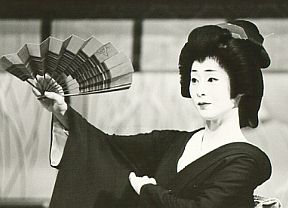The Art of Geisha

What attracts a woman to this profession is, above all, the conscious and deliberate choice to make art her life. (Dalby:217)

The importance of dance in the Japanese culture and to Geisha most likely originates
from ancient religious practices. The nineteenth century saw the development of many
of the dances that are now the most common dances performed by Geisha at both
private parties and public events such as festivals. Dances such as the Miyako
Odori and the cherry dances, dances that originate in the Japanese cultural value
of Cherry Blossoms, arise out of the nineteenth century.
The shamisen is a lute-like instrument made out of redwood with three strings of
braided silk attached to the arm by three large ivory pegs. The wooden body is
backed with parchment. The instrument is played with an ivory or hardwood plectrum.
The playing of the shamisen dates back to T'ang China when the instrument was given
as a gift from the T'ang court to Japanese Buddhist envoys.
Before discussing matters of appearance in Geisha, it is important to note the
significance of the color red. There is a word in Japanese, ko itten, which means
"touch of scarlet." The word is used as an affectionate term for women, especially
Geisha girls. The use of the color red in dress and makeup is very significant to
Japanese society. Red is denoted as a color of beauty and happiness. Red
undergarments are thought to ward off menstrual pain and keep the female
reproductive organs healthy and functioning. Red is also thought to be erotic to
men. Geishas traditionally wear crimson lining under their kimonos (depending on
season) as well as bright red lipstick made from safflower extract and red rouge,
made from the petals of crimson flowers.
In the early era of Geisha, when most patrons were shoguns, the costumes that the
Geisha Girls wore were very warrior-like, including large hats and decorative
swords. As the culture flourished, garments became much more feminine. Geisha began
to wear the traditional kimono. The color, pattern, and style of kimono was
dependent on season, but the kimono was always worn in three layers (the outer
kimono and two layers of undergarments), regardless of season. In the winter,
Geisha could be seen wearing a three-quarter length "overcoat" lined with hand
painted silk over their kimono. In the spring, the waistband that Geisha wear
(obi) became very important. During the springtime, the waistband was often more
expensive than the kimono and ornately decorated. The spring kimono also had a
crimson lining. Come summer, the lining was removed, and the kimonos were typically
of brighter colors and different designs. Again in autumn, the crimson lining would
reappear as well as new colors and designs. Geisha wore a flat-soled sandal
outdoors, and went barefoot indoors. When weather was bad, the women wore raised
wooden clogs that are attached to the foot in the same way that the usual thong
sandal is. Maiko, geisha in training, wore a special black lacquered wooden clog.
The hairstyles of Geisha have varied considerably over history. Before the time of
T'ang China, it was most common for women to wear their hair down but during the
time of T'ang China, it became popular to tie one's hair up. Women then returned
to wearing their hair parted in the center and hanging straight down. Again during
the seventeenth century, women began pulling all their hair up again and it is
during this time that the traditional hairstyle, shimada, developed. This is the
hairstyle worn by Geisha and means generally thatall the hair is pulled back in one
section. There are four major types of the shimada: Taka Shimada, a high chignon
(a kind of knot of hair), usually worn by young, single women; Tsubushi shimada, a more flattened chignon generally worn by older women; Uiwata, a chignon that is usually bound up with a piece of color cotton crepe; and a style that ends up looking like a divided peach, typically worn by maiko. These hairstyles were decorated with elaborate hair-combs and hairpins, which often symbolized status. In the seventeenth century and after the Meiji Restoration period, hair-combs were large and conspicuous, generally more ornate for higher-class women. During the Meiji restoration and in this modern era, smaller less conspicuous hair-combs are more popular.
The traditional makeup of the Geisha is probably the most common feature associated
with the culture because of its striking contrast to contemporary makeup. Under the
influence of T'ang China, early geisha and other women of the period would dye
their brows a golden yellow. Beginning in the Sixteenth century, the Geisha began
using a white foundation made from rice powder that has since been replaced by a
white cream. Geisha wear bright red lipstick, made from safflower extract and often
worn only in the center of the lips to emphasize delicacy, femininity and the
desired miniature effect. Light red rouge made from crimson flower petals was also worn. Until the Meiji period, Geisha and other performers were known to permanently stain their teeth black, the significance of which is not certain.
The world of Geisha is a culture that allows Japanese women to be independent and
economically self-sufficient, as they do not marry (as they would cease to be a
Geisha if she did).
It is probably the only profession in Japanese which the women
are consistently ranked above the men in the profession. Geisha also allows a woman
to work into old age and because of the high cultural value on this preservation of
traditional art and culture gives the woman an inherent value and respect that she
might otherwise be unable to obtain.
These are pictures of the traditional hair, makeup, and clothes of the Geisha
These are pictures of of traditional instruments and dance forms of the Geisha
